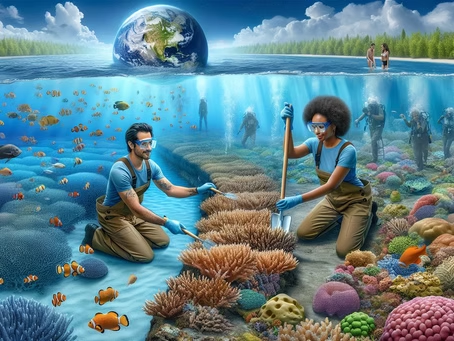Introduction
Marine habitats, especially seagrass meadows, are under severe threat globally. These underwater prairies are disappearing at an alarming rate, with profound consequences for marine biodiversity and human communities that depend on them. From fisheries to coastal protection, seagrasses play an irreplaceable role in sustaining life. This article highlights the urgent need for seagrass restoration, explores global initiatives such as Tobago’s Project MARIN, and examines how cultural, ecological, and economic values intertwine in conserving these ecosystems.
The Global Decline of Seagrass Meadows
An Urgent Crisis
Seagrass meadows are vanishing at a rate equivalent to a football field every 30 minutes. This rapid decline threatens marine species, coastal economies, and the health of our oceans. Pollution, poorly managed coastal development, and climate change drive much of this loss, making immediate restoration and protection efforts critical.
What’s at Stake
- The survival of marine species that rely on seagrass nurseries
- The economic prosperity of fisheries and tourism industries
- The resilience of oceans that regulate climate and support biodiversity
Cultural, Economic, and Ecological Value
Seagrasses hold deep cultural significance, from traditional celebrations among the Seri people of Mexico to symbolic roles in Pacific Island communities. Economically, they support fisheries by providing nursery grounds for commercially important species. Ecologically, they function as biodiversity hotspots, sheltering everything from tiny crustaceans to endangered manatees and turtles. Without seagrass, marine life and human livelihoods face immense challenges.
World Seagrass Day: Raising Awareness
Observed annually on March 1, World Seagrass Day serves as a reminder of their importance. It encourages reflection, education, and concrete action. On this day, communities and conservationists worldwide emphasize the urgency of protecting and restoring seagrass ecosystems for future generations.
Project MARIN: Tobago’s Restoration Effort
A Science-Driven Approach
The Institute of Marine Affairs in Tobago leads Project MARIN, a dedicated initiative to restore seagrass meadows. The project trials different replanting methods while accounting for factors such as water clarity, currents, and nutrient levels. By replanting in areas where seagrass once thrived, the project increases chances of success.
Challenges in Replanting
- Addressing pollution and coastal development pressures
- Selecting suitable sites with favorable ecological conditions
- Balancing restoration with long-term monitoring and community involvement
Seagrass as Biodiversity Hubs
Seagrass meadows are nurseries for fish and crustaceans, foraging grounds for species important to sport fishing, and feeding areas for turtles and manatees. These ecosystems amplify biodiversity, often supporting up to 20 times more marine life than barren seabeds. Their preservation is fundamental to healthy oceans.
Innovation and Collaboration
Emerging Techniques
- Precision planting guided by GPS and modeling
- Biodegradable structures to stabilize new shoots
- Genetic selection of resilient seagrass strains
Global Partnerships
Collaboration among governments, scientists, NGOs, and local communities enhances restoration outcomes. By combining policy support, technological innovation, and grassroots stewardship, these partnerships secure more resilient marine ecosystems.
Balancing Development and Ecology
Preservation is more effective than restoration. Sustainable coastal development must integrate seagrass conservation by planning projects carefully, creating buffer zones, and promoting eco-friendly tourism. Thoughtful development ensures progress without sacrificing marine habitats that sustain economies and biodiversity.
Community Involvement
Local engagement strengthens conservation. Educational programs, beach cleanups, and citizen science initiatives inspire stewardship and encourage communities to protect marine ecosystems. Projects like Project MARIN demonstrate that local action can have global impact, turning awareness into measurable change.
Pollution and Its Impacts
Land-based pollution—from agriculture, industry, and urban runoff—remains a primary driver of seagrass loss. Addressing pollution requires reducing runoff, implementing clean boating practices, and adopting sustainable development strategies. These actions create healthier coastal environments where seagrasses can recover.
The Ripple Effect of Restoration
Healthy seagrass meadows improve fisheries, sustain livelihoods, stabilize coastlines, and sequester carbon at impressive rates. They also enhance water quality by filtering sediments and nutrients. The benefits extend beyond the sea, directly improving human well-being and economic resilience.
Conclusion
Seagrass meadows are unsung heroes of marine ecosystems, vital to biodiversity, livelihoods, and climate stability. Their decline is alarming, but restoration projects like Tobago’s Project MARIN prove recovery is possible. Through innovation, collaboration, and community action, we can restore these underwater prairies and secure a healthier ocean future. Protecting seagrass is not only an environmental necessity but also an investment in cultural heritage and human prosperity.

